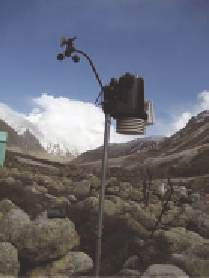Environmental Engineering Reference
In-Depth Information
Figure 3. An automatic weather station installed
in the himalayas (photo: dr rajesh kumar)
to be conducted. Also, complex interaction of
spatial scales in weather and climate phenomena
in mountains is not given sufficient importance
at most of the times.
In agro based ecosystems the use of ICT tools
is relatively less complex as it does not entail large
investments and monitoring of weather param-
eters can be undertaken with low cost methods
and solutions.
The need of the hour is to make use of modern
tools such as satellite technology and weather
stations and use the results for policy formulation
on adaptation issues for the different ecosystem
regions as well as catchment or watershed areas
which are dependent on them. A multi disciplinary
approach is required to integrate the ecosystem
research in various sectors and across different
stakeholders in order to promote sustainable
growth models.
Technology interventions require a paradigm
shift in bringing societal benefits in the face of
environmental stresses. While there have been
some good examples of technology - academia-
civil society interface in this direction, much needs
to be done to bring the fruits of state of the art
tools at the doorstep of large sections of society.
The tremendous growth in telecommunication
technologies has seen an increased economic
growth and prosperity across many parts of the
world. In countries like Bangladesh, the concept
of Grameen phone has helped empower some of
the rural populace to enable them to move into
the mainstream of society.
Future research trends are likely to focus at
developing and implementing low carbon tech-
nologies particularly in the renewable energy
sector. Decentralised rural energy generation from
solar and bio mass power are being seen as solu-
tions to a sustainable future. The recent national
Action Plan on Climate change by the Govern-
ment of India released in 2008 provides clear
focus towards sectors like solar energy, energy
efficient technologies and increasing capacity of
•
Preferably human-readable without refor-
matting
- to assist in the quality monitoring
of the data
•
Independent of AWS manufacturer
- to al-
low data to be easily exchanged between
agencies and to encourage cost competi-
tiveness between manufacturers
•
Unambiguous
- the use of features such
as check-sums minimise the possibility of
data corruption
FUTURE RESEARCH TRENDS
The need for continuous monitoring of ecosystems
necessitates the availability of state of the art
technology and tools apart from regular capacity
building of manpower to use the technologies.
Various ecosystems have their own inherent limita-
tions for use of ICT based tools. It can be said that
though there have been many studies conducted
on Himalayan glaciers the lack of baseline data
poses as a major limitation in most of the cases.
Continuous records for climate characteristics &
meteorological observations are rarely available.
In most cases there is no weather station at the
high altitude locations. Rough terrain and harsh
conditions make regular research more difficult

